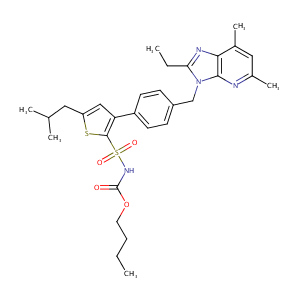Details of the Drug
General Information of Drug (ID: DMZOW96)
| Drug Name |
L-162313
|
||||||||||||||||||||||
|---|---|---|---|---|---|---|---|---|---|---|---|---|---|---|---|---|---|---|---|---|---|---|---|
| Synonyms |
L-162,313; 151488-11-8; L-162313; CHEMBL288174; butyl 3-(4-((2-ethyl-5,7-dimethyl-3H-imidazo[4,5-b]pyridin-3-yl)methyl)phenyl)-5-isobutylthiophen-2-ylsulfonylcarbamate; 5,7-Dimethyl-2-ethyl-3-[[4-[2-(n-butyloxycarbonylsulfonamido)-5-isobutyl-3-thienyl]phenyl]methyl]imidazo-[4,5-b]-pyridine; 5,7-Dimethyl-2-ethyl-3-[[4-[2(N-butyloxycarbonylsulfonamido)-5-isobutyl-3-thienyl]phenyl]methyl]Imidazo[4,5,6]pyridine; L 162313; Lopac-L-1415; AC1O7G4F; Lopac0_000697; MLS002153426; SCHEMBL9132197; GTPL3936; C30H38N4O4S2; HMS3262K15
|
||||||||||||||||||||||
| Indication |
|
||||||||||||||||||||||
| Drug Type |
Small molecular drug
|
||||||||||||||||||||||
| Structure |
 |
||||||||||||||||||||||
| 3D MOL | 2D MOL | ||||||||||||||||||||||
| #Ro5 Violations (Lipinski): 3 | Molecular Weight (mw) | 582.8 | |||||||||||||||||||||
| Logarithm of the Partition Coefficient (xlogp) | 7.6 | ||||||||||||||||||||||
| Rotatable Bond Count (rotbonds) | 12 | ||||||||||||||||||||||
| Hydrogen Bond Donor Count (hbonddonor) | 1 | ||||||||||||||||||||||
| Hydrogen Bond Acceptor Count (hbondacc) | 7 | ||||||||||||||||||||||
| Chemical Identifiers |
|
||||||||||||||||||||||
| Cross-matching ID | |||||||||||||||||||||||
Molecular Interaction Atlas of This Drug
 Drug Therapeutic Target (DTT) |
|
|||||||||||||||||||||||||||||||
|---|---|---|---|---|---|---|---|---|---|---|---|---|---|---|---|---|---|---|---|---|---|---|---|---|---|---|---|---|---|---|---|---|
| Molecular Interaction Atlas (MIA) | ||||||||||||||||||||||||||||||||
Molecular Expression Atlas of This Drug
| The Studied Disease | Discovery agent | |||||||||||||||||||||||
|---|---|---|---|---|---|---|---|---|---|---|---|---|---|---|---|---|---|---|---|---|---|---|---|---|
| ICD Disease Classification | N.A. | |||||||||||||||||||||||
|
||||||||||||||||||||||||
| Molecular Expression Atlas (MEA) | ||||||||||||||||||||||||
References
